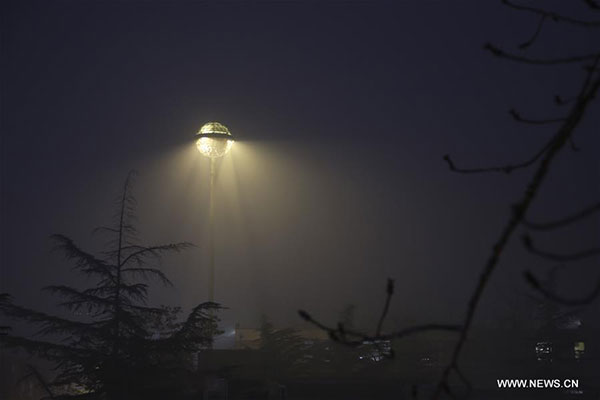
Photo taken on Dec 22, 2015 shows a view of smog in Beijing, Dec 22, 2015.[Photo/Xinhua]
Tianjin issued its first red alert for smog on Tuesday, following Beijing and some cities in Hebei province that had already raised the highest-level warning. It is the first time that jurisdictions in the three areas have taken this step.
Under the red alert, Tianjin has introduced emergency measures that include restricting traffic and suspending industrial production to curb air pollution. The measures will be in effect from Wednesday until 6 am on Thursday.
The move was taken after four cities in Hebei-Baoding, Handan, Langfang and Xingtai-had already been placed under a red alert, which lasts until Friday. Beijing's second red alert, issued on Friday, was due to end at midnight on Tuesday.
Cities in the region have different standards for issuing air pollution alerts, according to Sun Ren, chief engineer at the Tianjin Environmental Protection Bureau.
Sun said Tianjin issues a red alert for smog only when the Air Quality Index reading stays above 500 for at least a day, which indicates extremely bad air quality.
Hebei can issue a red alert when the index reaches 500 for a day in a certain number of its cities, under its Provincial Severe Air Pollution Emergency Plan. But a provincial-level red alert was not issued.
Beijing can issue a red alert when air pollution levels equivalent to an AQI reading of 200 and above are forecast to last for at least three days.
Wang Bin, head of the Emergency Response Department at the Beijing Environmental Protection Bureau, said the city has become more cautious in safeguarding its air quality and has imposed stricter standards for issuing alerts. "If the upgraded standards had not been in place, Beijing would have issued only orange or yellow alerts for the ongoing weather conditions. So the red alert we have now does not necessarily mean air conditions are becoming worse than in the past," Wang said.
Beijing is seeking to further revise its Severe Air Pollution Emergency Plan and to work out uniform standards with Tianjin and Hebei for issuing alerts and taking emergency measures, Wang said.
He said that based on the integrated development plan for Beijing, Tianjin and Hebei, the three areas have already made some breakthroughs in jointly controlling air pollution.







